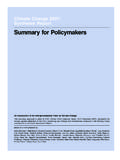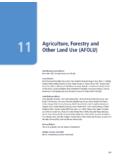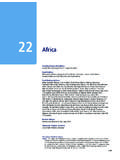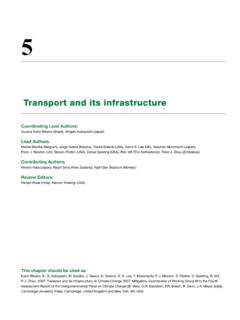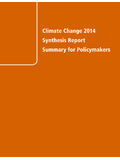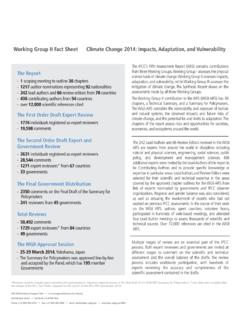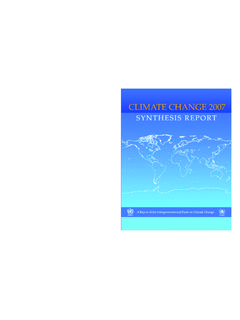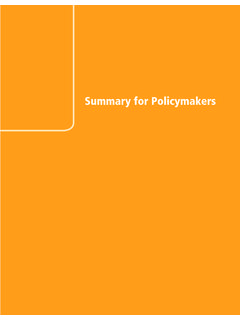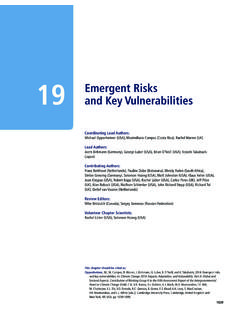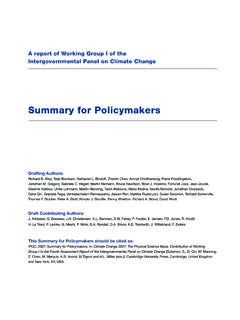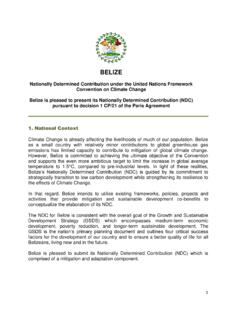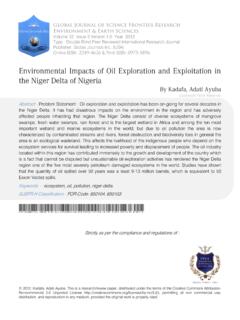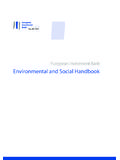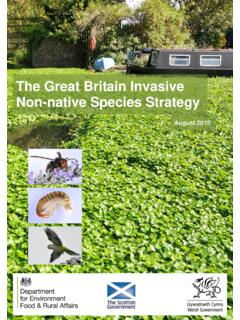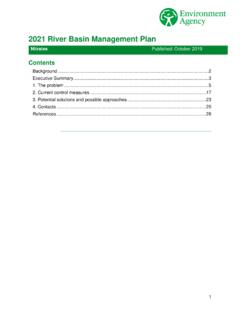Transcription of INTERGOVERNMENTAL PANEL ON climate change
1 INTERGOV ERNMENTA L PA NEL ON climate change WG II. WORKING GROUP II CONTRIBUTION TO THE. FIFTH ASSESSMENT REPORT OF THE. INTERGOVERNMENTAL PANEL ON climate change . Summary SPM for Policymakers Drafting Authors: Christopher B. Field (USA), Vicente R. Barros (Argentina), Michael D. Mastrandrea (USA), Katharine J. Mach (USA), Mohamed Abdrabo (Egypt), W. Neil Adger (UK), Yury A. Anokhin (Russian Federation), Oleg A. Anisimov (Russian Federation), Douglas J. Arent (USA), Jonathon Barnett (Australia), Virginia R. Burkett (USA), Rongshuo Cai (China), Monalisa Chatterjee (USA/India), Stewart J. Cohen (Canada), Wolfgang Cramer (Germany/France), Purnamita Dasgupta (India), Debra J.
2 Davidson (Canada), Fatima Denton (Gambia), Petra D ll (Germany), Kirstin Dow (USA), Yasuaki Hijioka (Japan), Ove Hoegh-Guldberg (Australia), Richard G. Jones (UK), Roger N. Jones (Australia), Roger L. Kitching (Australia), R. Sari Kovats (UK), Joan Nymand Larsen (Iceland), Erda Lin (China), David B. Lobell (USA), I igo J. Losada (Spain), Graciela O. Magrin (Argentina), Jos A. Marengo (Brazil), Anil Markandya (Spain), Bruce A. McCarl (USA), Roger F. McLean (Australia), Linda O. Mearns (USA), Guy F. Midgley (South Africa), Nobuo Mimura (Japan), John F. Morton (UK), Isabelle Niang (Senegal), Ian R. Noble (Australia), Leonard A. Nurse (Barbados), Karen L.
3 O'Brien (Norway), Taikan Oki (Japan), Lennart Olsson (Sweden), Michael Oppenheimer (USA), Jonathan T. Overpeck (USA), Joy J. Pereira (Malaysia), Elvira S. Poloczanska (Australia), John R. Porter (Denmark), Hans-O. P rtner (Germany), Michael J. Prather (USA), Roger S. Pulwarty (USA), Andy Reisinger (New Zealand), Aromar Revi (India), Patricia Romero-Lankao (Mexico), Oliver C. Ruppel (Namibia), David E. Satterthwaite (UK), Daniela N. Schmidt (UK), Josef Settele (Germany), Kirk R. Smith (USA), D ith A. Stone (Canada/South Africa/USA), Avelino G. Suarez (Cuba), Petra Tschakert (USA), Riccardo Valentini (Italy), Alicia Villamizar (Venezuela), Rachel Warren (UK), Thomas J.
4 Wilbanks (USA), Poh Poh Wong (Singapore), Alistair Woodward (New Zealand), Gary W. Yohe (USA). This Summary for Policymakers should be cited as: IPCC, 2014: Summary for policymakers. In: climate change 2014: Impacts, Adaptation, and Vulnerability. Part A: Global and Sectoral Aspects. Contribution of Working Group II to the Fifth Assessment Report of the INTERGOVERNMENTAL PANEL on climate change [Field, , Barros, Dokken, Mach, Mastrandrea, Bilir, M. Chatterjee, Ebi, Estrada, Genova, B. Girma, Kissel, Levy, S. MacCracken, Mastrandrea, and White (eds.)]. Cambridge University Press, Cambridge, United Kingdom and New York, NY, USA, pp. 1-32. 1. Summary for Policymakers Contents Assessing and Managing the Risks of climate change .
5 3. Background Box Context for the Assessment .. 4. Background Box Terms Central for Understanding the Summary .. 5. Background Box Communication of the Degree of Certainty in Assessment Findings .. 6. A: Observed Impacts, Vulnerability, and Adaptation in a Complex and Changing World .. 4. A-1. Observed Impacts, Vulnerability, and Exposure .. 4. A-2. Adaptation Experience .. 8. A-3. The Decision-making Context .. 9. B: Future Risks and Opportunities for Adaptation .. 11. B-1. Key Risks across Sectors and Regions .. 11. Assessment Box Human Interference with the climate System .. 12. B-2. Sectoral Risks and Potential for Adaptation .. 14. B-3. Regional Key Risks and Potential for Adaptation.
6 20. Assessment Box Regional Key Risks .. 21. C: Managing Future Risks and Building Resilience .. 25. C-1. Principles for Effective Adaptation .. 25. C-2. climate -resilient Pathways and Transformation .. 28. Supplementary Material .. 30. 2. Summary for Policymakers ASSESSING AND MANAGING THE RISKS OF climate change . Human interference with the climate system is occurring,1 and climate change poses risks for human and natural systems (Figure ). The assessment of impacts, adaptation, and vulnerability in the Working Group II contribution to the IPCC's Fifth Assessment Report (WGII AR5). evaluates how patterns of risks and potential benefits are shifting due to climate change .
7 It considers how impacts and risks related to climate change can be reduced and managed through adaptation and mitigation. The report assesses needs, options, opportunities, constraints, SPM. resilience, limits, and other aspects associated with adaptation. climate change involves complex interactions and changing likelihoods of diverse impacts. A focus on risk, which is new in this report, supports decision making in the context of climate change and complements other elements of the report. People and societies may perceive or rank risks and potential benefits differently, given diverse values and goals. Compared to past WGII reports, the WGII AR5 assesses a substantially larger knowledge base of relevant scientific, technical, and socioeconomic literature.
8 Increased literature has facilitated comprehensive assessment across a broader set of topics and sectors, with expanded coverage of human systems, adaptation, and the ocean. See Background Box Section A of this summary characterizes observed impacts, vulnerability and exposure, and adaptive responses to date. Section B examines future risks and potential benefits. Section C considers principles for effective adaptation and the broader interactions among adaptation, mitigation, IMPACTS. climate Vulnerability SOCIOECONOMIC. PROCESSES. Natural Socioeconomic Variability Pathways Hazards RISK. R Adaptation and Mitigation Anthropogenic Actions climate change Governance Exposure EMISSIONS.
9 And Land-use change Figure | Illustration of the core concepts of the WGII AR5. Risk of climate -related impacts results from the interaction of climate -related hazards (including hazardous events and trends) with the vulnerability and exposure of human and natural systems. Changes in both the climate system (left) and socioeconomic processes including adaptation and mitigation (right) are drivers of hazards, exposure, and vulnerability. [ , Figure 19-1]. 1 A key finding of the WGI AR5 is, It is extremely likely that human influence has been the dominant cause of the observed warming since the mid-20th century.. [WGI AR5 SPM Section , , , , ]. 2 , Figure 1-1.
10 3. Summary for Policymakers Background Box | Context for the Assessment For the past 2 decades, IPCC's Working Group II has developed assessments of climate - change impacts, adaptation, and vulnerability. The WGII AR5 builds from the WGII contribution to the IPCC's Fourth Assessment Report (WGII AR4), published in 2007, and the SPM Special Report on Managing the Risks of Extreme Events and Disasters to Advance climate change Adaptation (SREX), published in 2012. It follows the Working Group I contribution to the AR5 (WGI AR5).3. The number of scientific publications available for assessing climate - change impacts, adaptation, and vulnerability more than doubled between 2005 and 2010, with especially rapid increases in publications related to adaptation.
